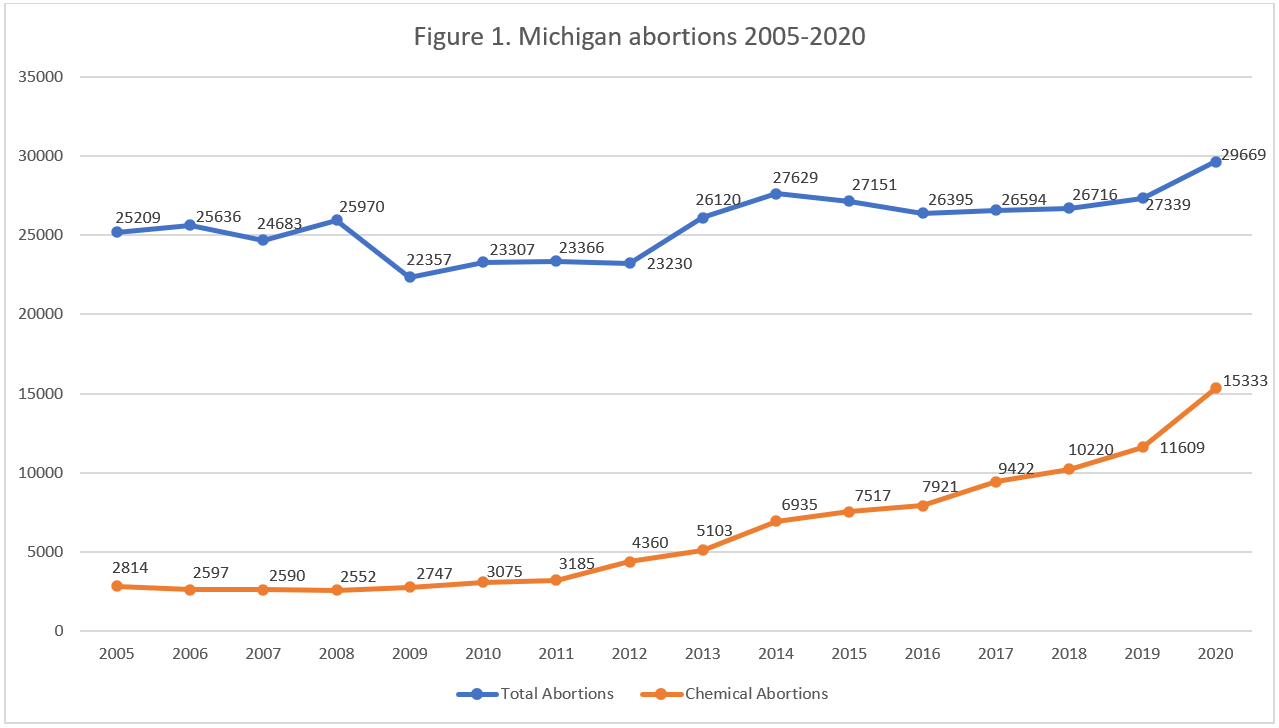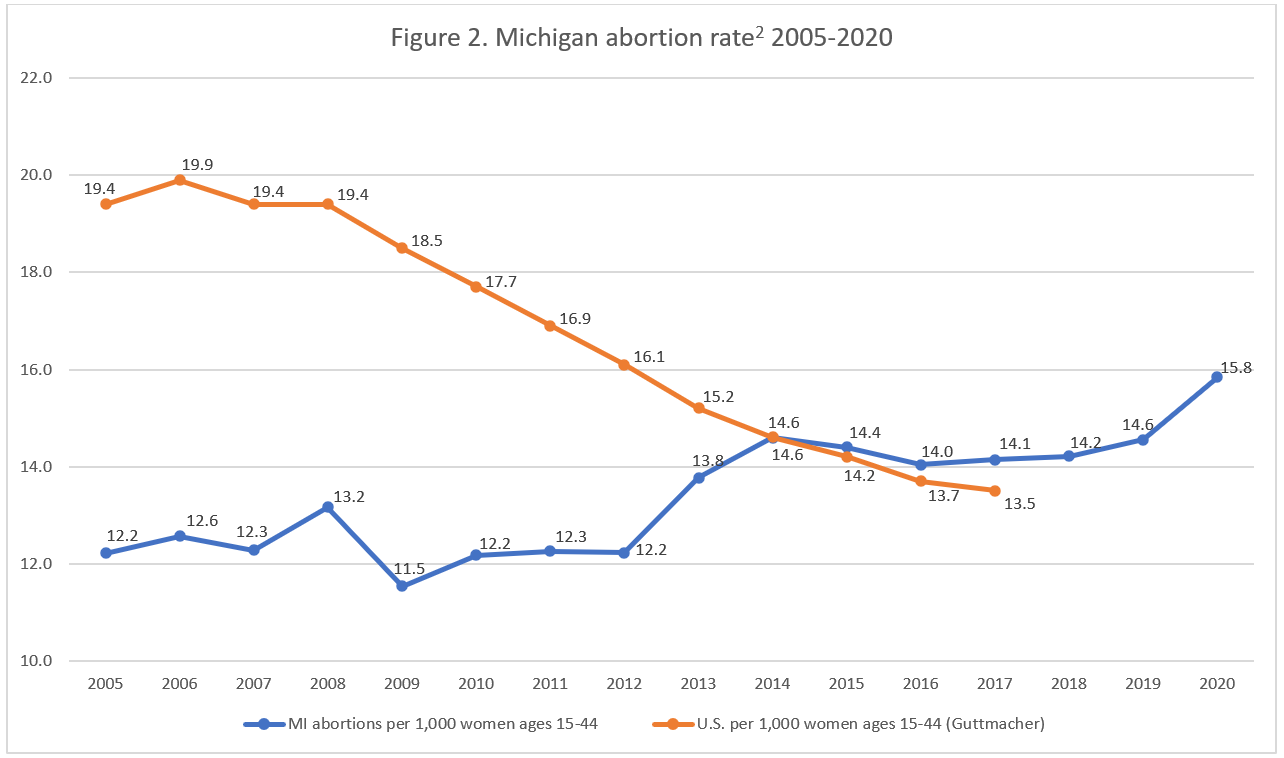Abortion Reporting: Michigan (2020)
The Michigan Department of Health and Human Services published Michigan’s 2020 abortion statistics in May 2021, showing that abortions are up in the Great Lakes State.
Changes in Michigan Abortions, 2019-2020

The report does not include information on Planned Parenthood’s Michigan abortion market share.
Abortion Totals and Trends
In 2020, there were 29,669 abortions reported in Michigan, up nearly nine percent from the previous year and the highest total reported since 1996. Chemical abortions jumped by 32 percent, making up 52 percent of the total in 2020 (Fig. 1). The Charlotte Lozier Institute (CLI) estimates that Michigan’s 2020 abortion rate was 15.8 abortions per 1,000 women ages 15 to 44, an increase from 2019 and higher than the national rate (Fig. 2). As of December 2021, 23 states had released 2020 abortion statistics, of which 16 showed that abortions had increased.
State Report Summary
Resident Abortions
In 2020, 95 percent of Michigan abortions were performed on residents, and much of the information in Michigan’s report is for residents only. Eight percent of the abortions performed on Michigan residents were on girls younger than 20, and 28 percent were on women ages 20 to 24. Thirty-one percent were on women ages 25 to 29, and 29 percent were on women ages 30 to 39. Three percent of the abortions were performed on women in their forties or older, and half a percent were on women whose age was not reported.
Over half of Michigan resident abortions were performed on black women (53 percent), while 37 percent were obtained by white women. Two percent were performed on Asian or Pacific Islander women, 0.6 percent on American Indian women, and another two percent each on multiracial women and women of other races. Race was not reported for four percent of the abortions. Michigan reports ethnicity separately from race, and three percent of resident abortions were performed on Hispanic women.
Ten percent of resident abortions were on married women, 85 percent on unmarried women, and five percent on women of unknown marital status. A third of the abortions were performed on women with no previous term pregnancies. Twenty-six percent were on women with one prior term pregnancy, and 41 percent were on women with two or more. Just over half the abortions (51 percent) were on women who reported no previous abortions; a quarter were on women with one prior abortion, and 24 percent were on women with more than one. Twenty-four percent of the abortions were performed on women who previously had had a miscarriage.
Michigan records the entity that referred each woman to the abortion facility, and in 2020 a majority of the abortions (88 percent) were self-referrals. Ten percent of the women undergoing abortions were referred by friends or family members, and one percent were referred by a physician. Forty-one women were referred by a family planning agency, 17 women by clergy, six by a health department, and four by a social agency. There were 194 women (0.7 percent) who received some other referral. The source of referral was not reported for 55 abortions. The vast majority of the abortions performed on Michigan residents, 96 percent, were self-pay, while four percent were covered by insurance.
Total Abortions
Seventy percent of all abortions reported in Michigan occurred at eight weeks of gestation or earlier, with 1.5 percent performed before five weeks of gestation and 68 percent performed between five and eight weeks. Nineteen percent were performed between nine and 12 weeks. Seven percent of the abortions occurred from 13 to 16 weeks of gestation, and three percent were performed between 17 and 20 weeks. There were 349 abortions, 1.2 percent of the total, performed at 21 weeks and later; of these, 342 abortions were performed between 21 and 24 weeks, five between 25 and 28 weeks, and two at 28 weeks of gestation or later. Gestational age was not reported for 0.4 percent (104) of the abortions.
A majority of the abortions reported in Michigan, 52 percent, were by chemical means. Forty-one percent were suction curettage procedures, and six percent were dilation and evacuation (dismemberment) abortions. There were two saline or prostaglandin abortions, two dilation and curettage abortions, and two hysterotomy or hysterectomy procedures. Twenty-six abortions were performed using some other means, while the type of procedure used was not reported for 0.4 percent.
In 93 percent of cases, pregnancy was confirmed via ultrasound. For four percent, pregnancy was confirmed with a home urine test, and for three percent, pregnancy was determined with a lab urine test. There were 26 pregnancies confirmed using a lab blood test, 59 in which another method was used, and three in which the method of confirming pregnancy was not reported. There were 22 abortions for which no method was used to confirm pregnancy.
Eighty-nine percent of Michigan abortions were performed in freestanding abortion facilities. Three percent were performed in doctor’s offices, 0.5 percent in hospitals, and seven percent in some other type of facility. Four percent (1,142) of the unborn babies killed by abortion weighed one to 99 grams, and two percent weighed between 100 and 399 grams. There were 121 babies who weighed 400 grams or more (0.4 percent). However, weight was not determinable for 94 percent of the unborn babies.
Abortion Complications
There were seven abortions that resulted in eight complications reported during the abortion procedure, including four instances of hemorrhage, two cases of shock, and two cervical lacerations.1 Additionally, 75 abortions resulted in 76 complications reported subsequent to the abortion procedure. There were 29 failed abortions, which usually indicates that the abortion did not work and the pregnancy is ongoing. There were 19 cases of retained products, six instances of hemorrhage, five infections, and two cervical lacerations. Shock, uterine perforation, and an allergic response each occurred one time. There were also 12 unspecified complications.
Of the 75 abortions resulting in post-abortion complications, 35 were suction curettage procedures and 31 were chemical. Eight of the abortions causing complications were dilation and evacuation abortions, and one was performed using hysterectomy or hysterotomy. Unlike other states, chemical abortions had a lower reported complication rate than surgical abortions; this may have been the result of a higher complication rate from late-term abortions or some chemical abortion complications going unreported. Abortions after 17 weeks of gestation accounted for at least nine percent of the complications, even though they composed just four percent of all Michigan abortions, and most of these later abortions were performed surgically. The number of late-term abortions with complications could have been higher, since gestational age was not reported for every complication.
State Ranking
In 2016, CLI published a paper surveying abortion reporting across the country, and Michigan’s reports tied for seventh best. As CLI has previously recommended, Michigan could make its reporting even better by providing detailed information for all abortions occurring in the state, not just those performed on residents. Additionally, Michigan could identify the states from which nonresident women travel for abortions.


Statistics on abortion complications reported here represent a minimal number of deaths and complications, as this data is collected in a non-systematic and non-verifiable way. As such, this data cannot be used to calculate either an accurate abortion mortality rate or an accurate abortion complication rate for the state.
- Rates were calculated by CLI using the following formula: (total number of abortions performed in Michigan ÷ number of resident women ages 15-44) x 1,000. Rates may differ slightly from previous CLI articles due to revised population estimates. Population estimates were obtained from the CDC WONDER database.


























